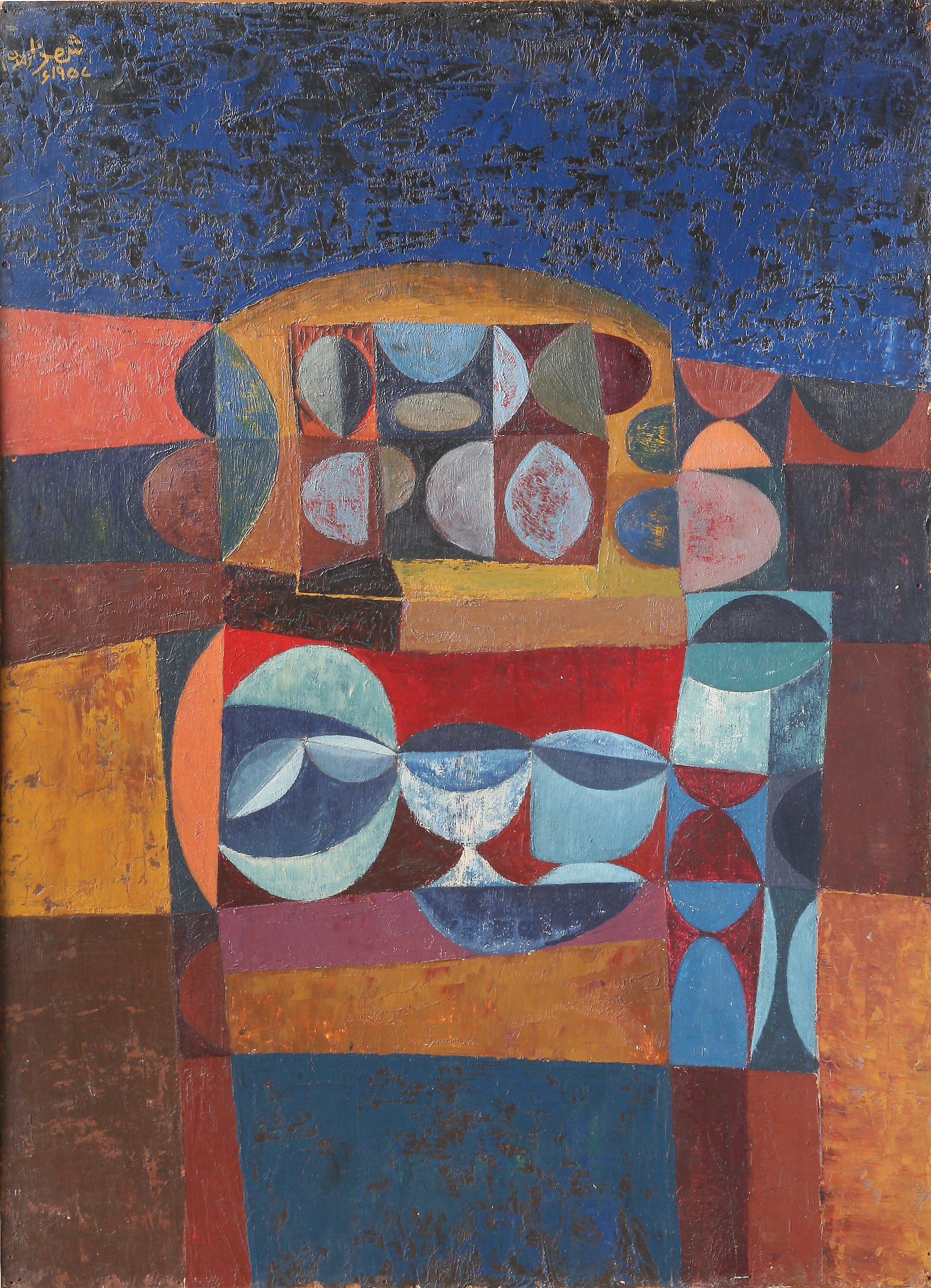Shemza Digital: Across Generations
14th January - 16th April 2023 - Wolverhampton Art Gallery and online
“The abstract art of Anwar Jalal Shemza gets a digital reboot by his granddaughter Aphra Shemza.”
— Jonathan Jones
“This exhibition is something of the future; visitors can delve into a digital world as well as being part of it. This is just the start of an exciting programme that Wolverhampton art Gallery has to offer for 2023.”
— Councillor Stephen Simkins



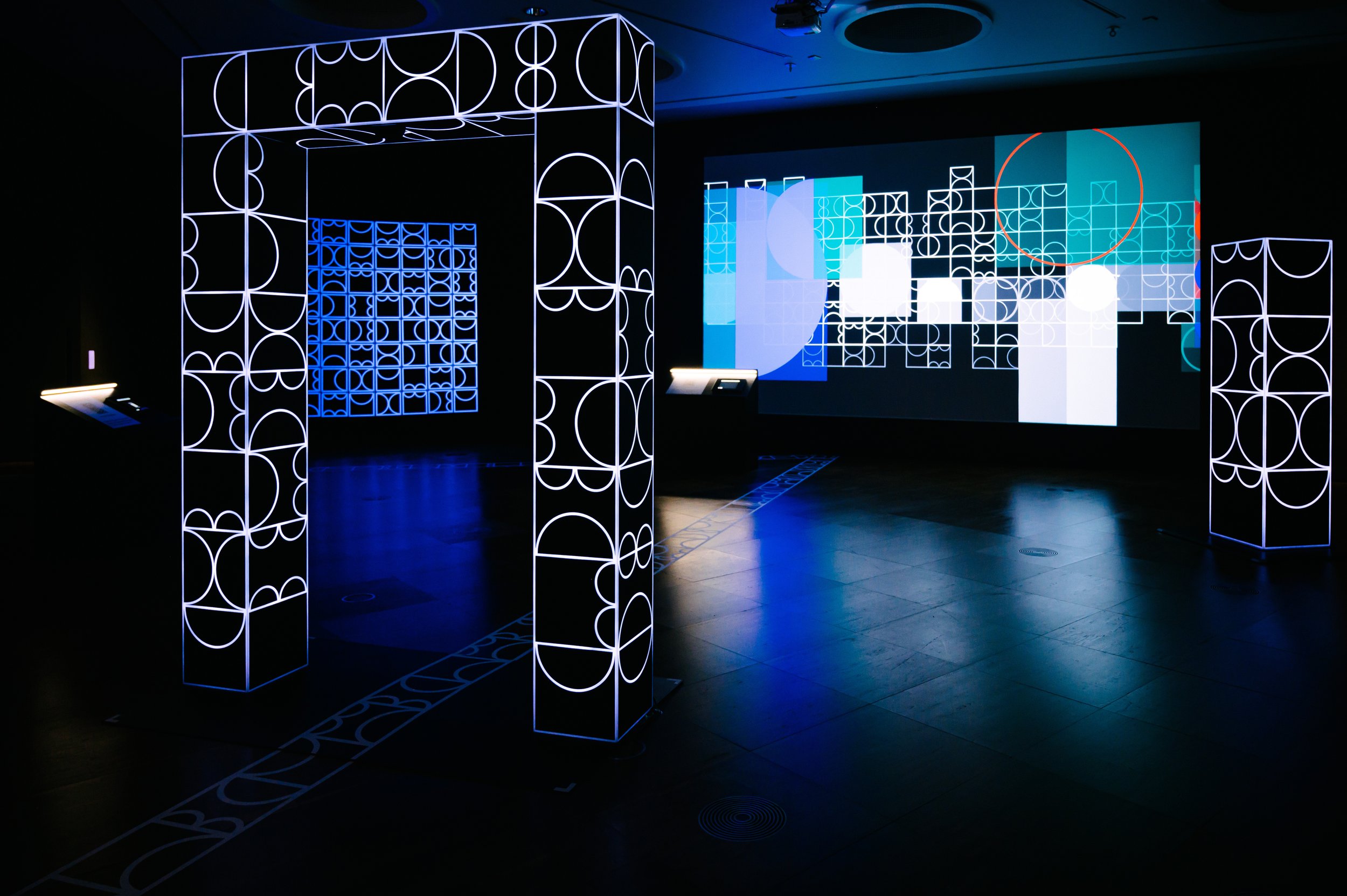
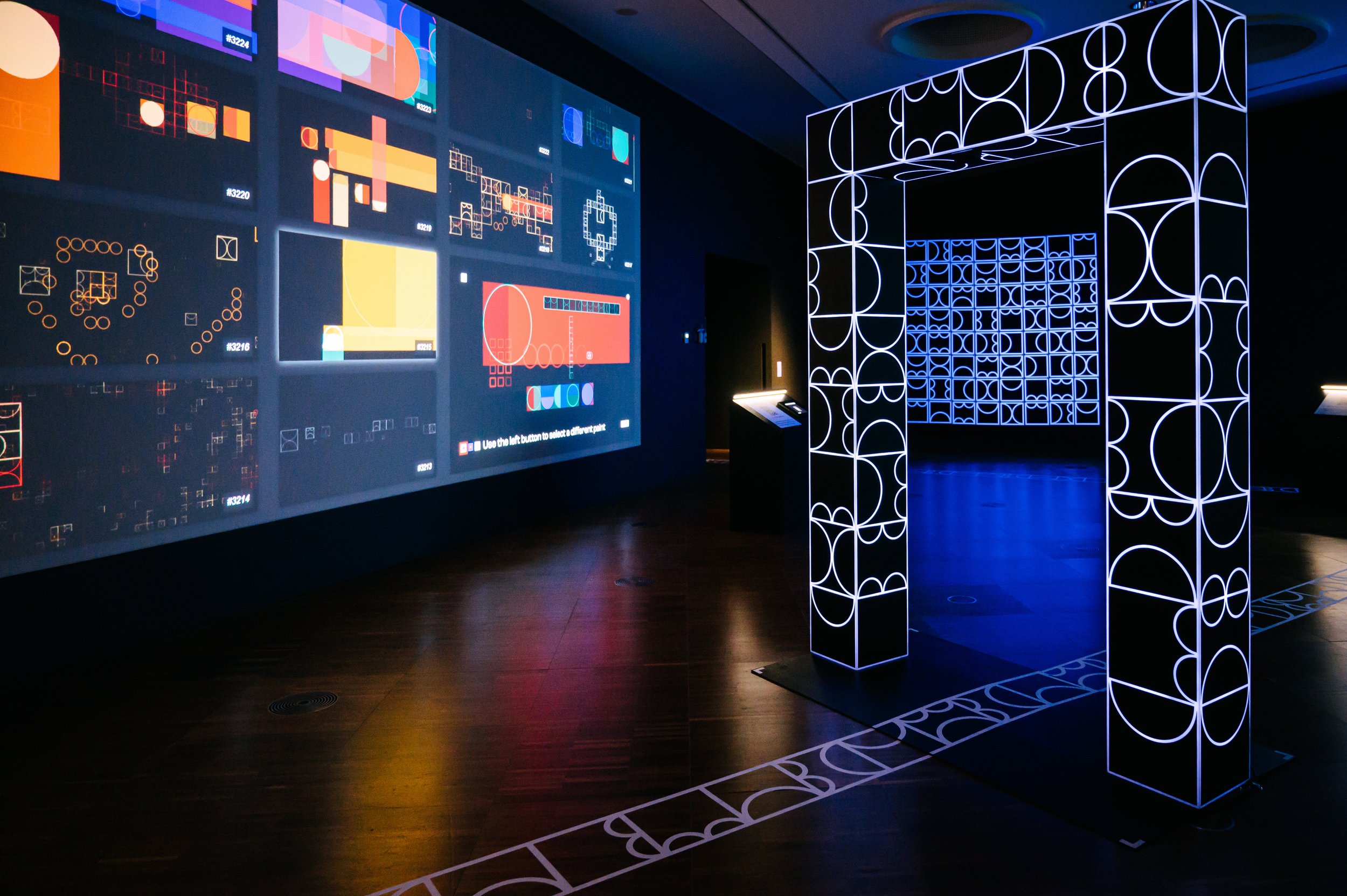





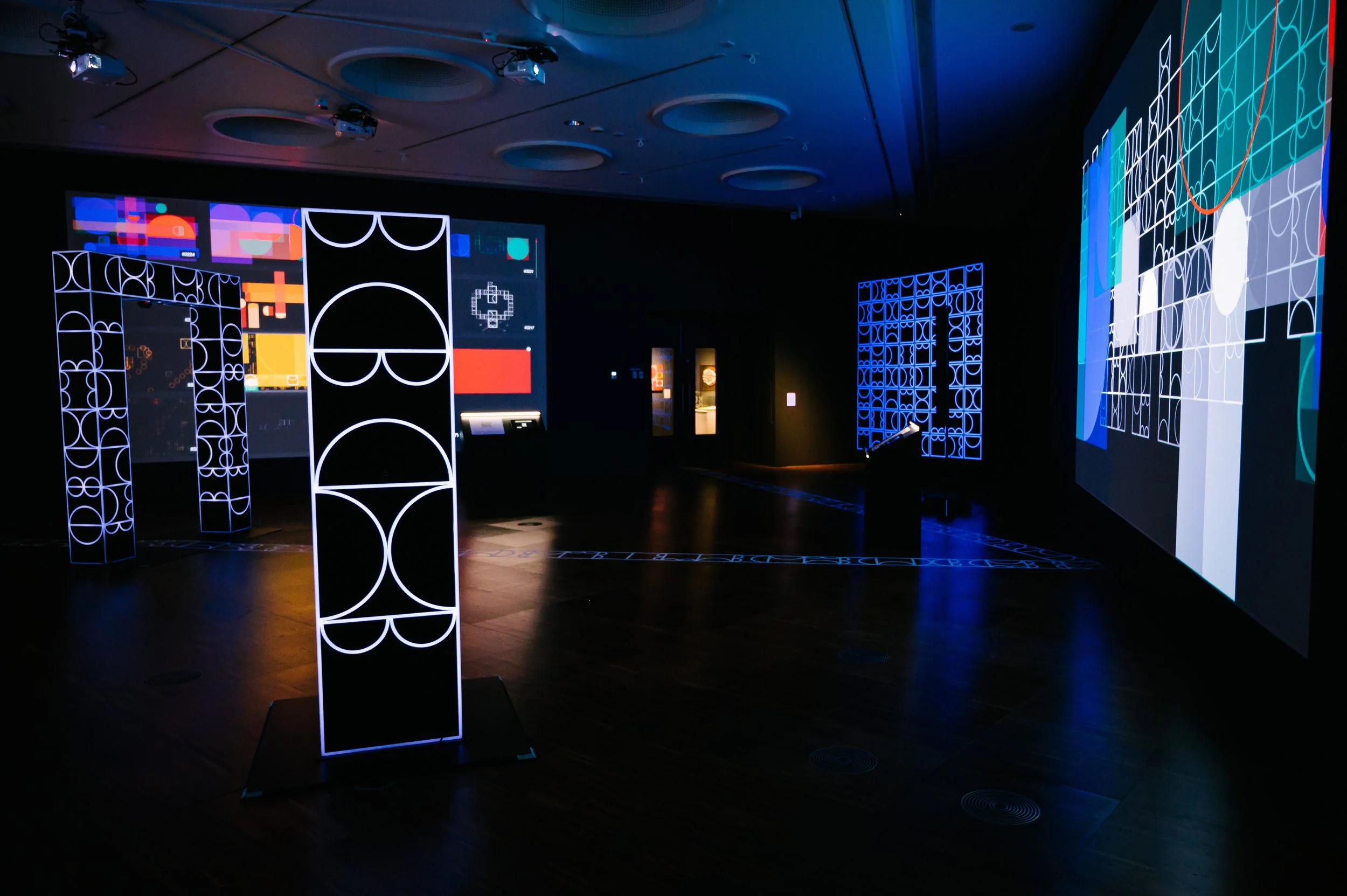



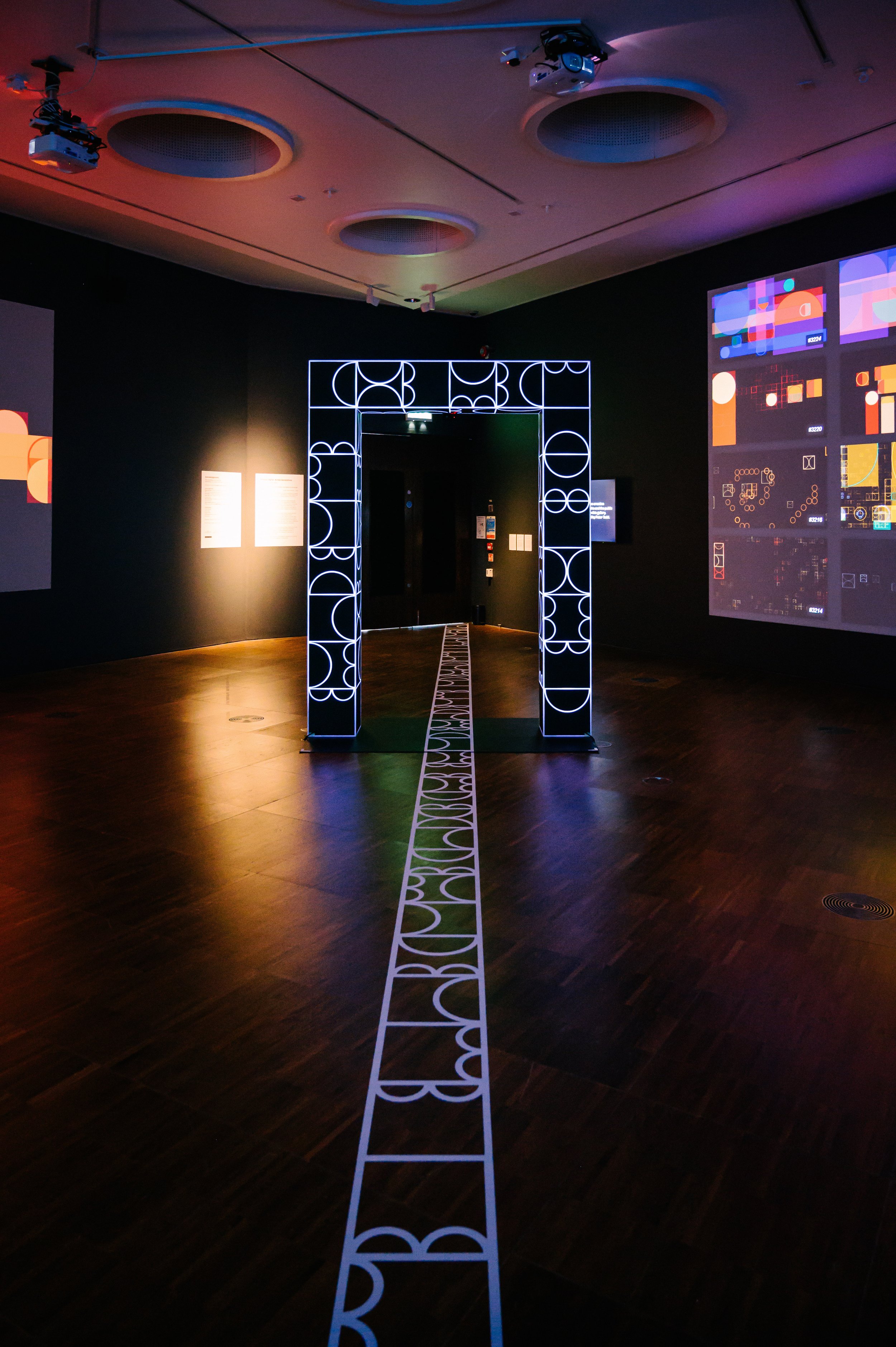
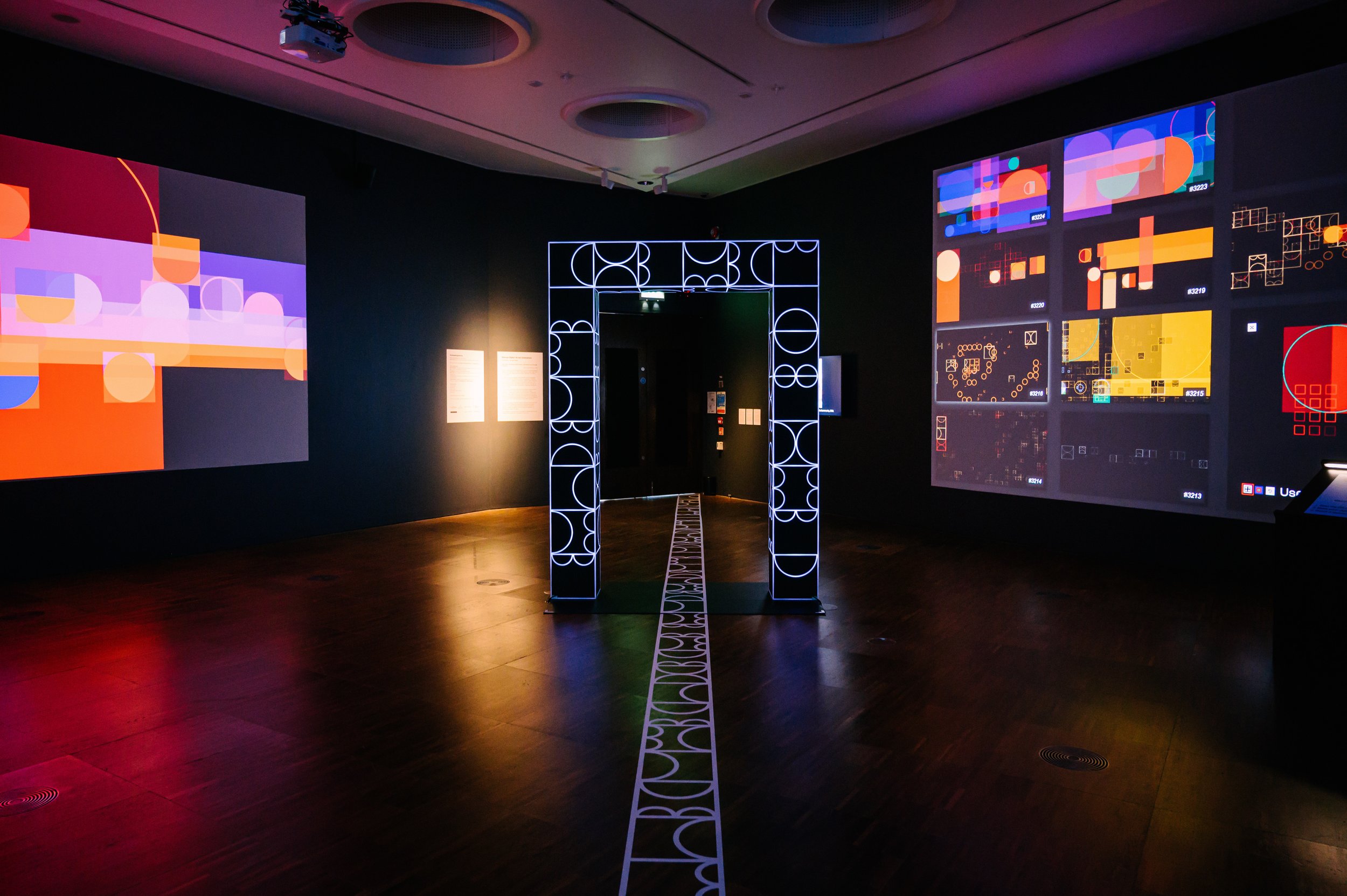





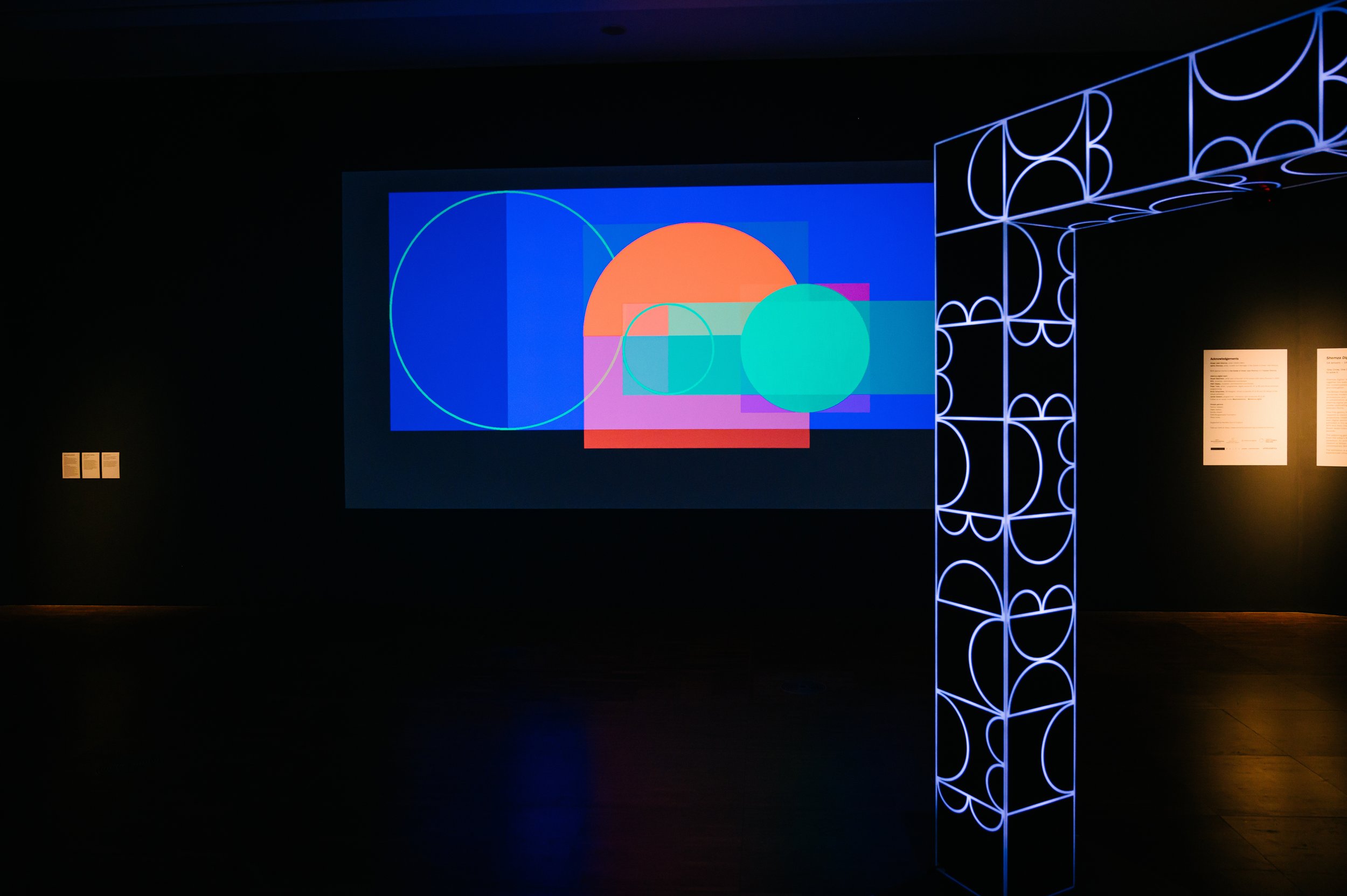






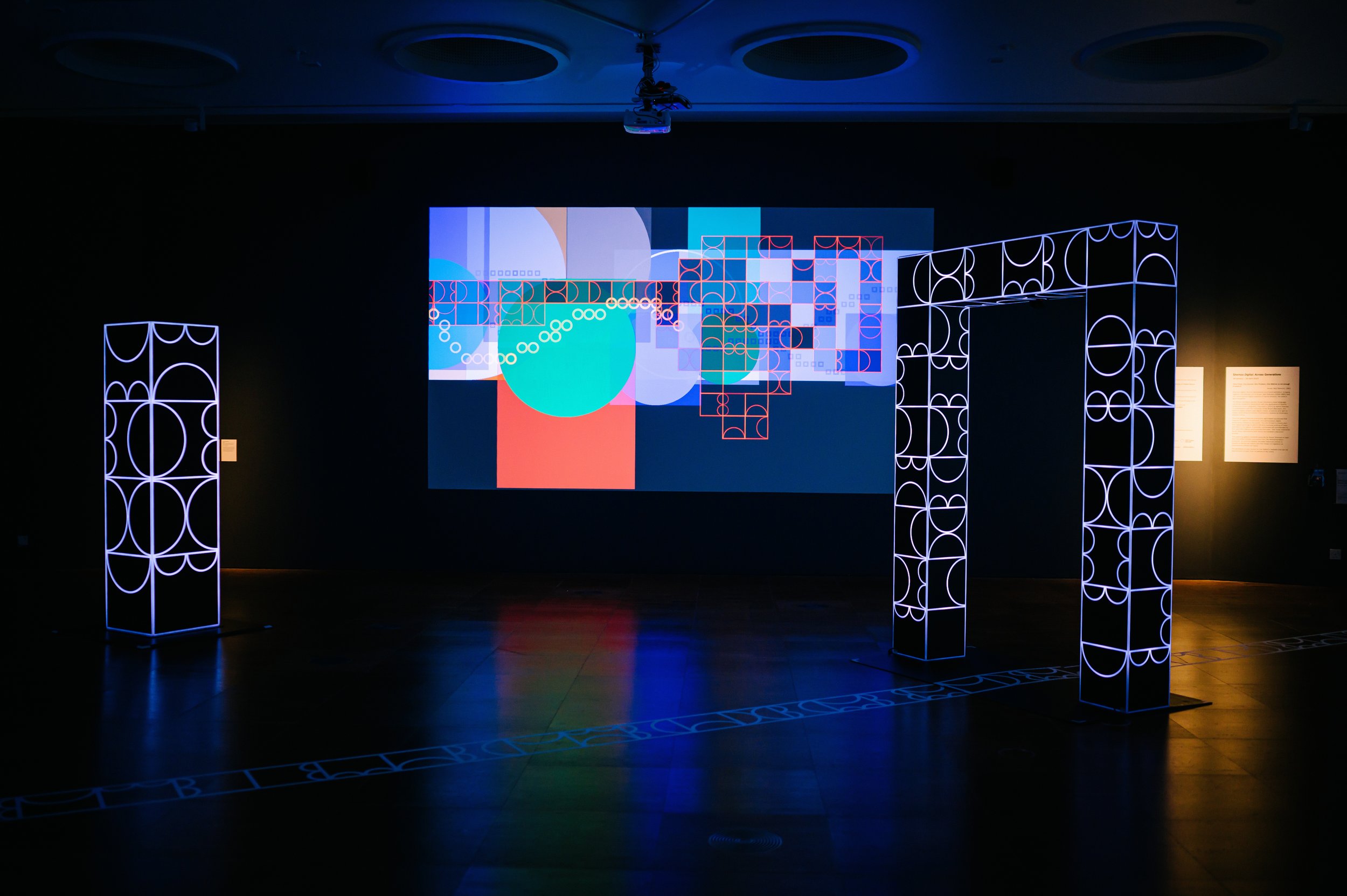

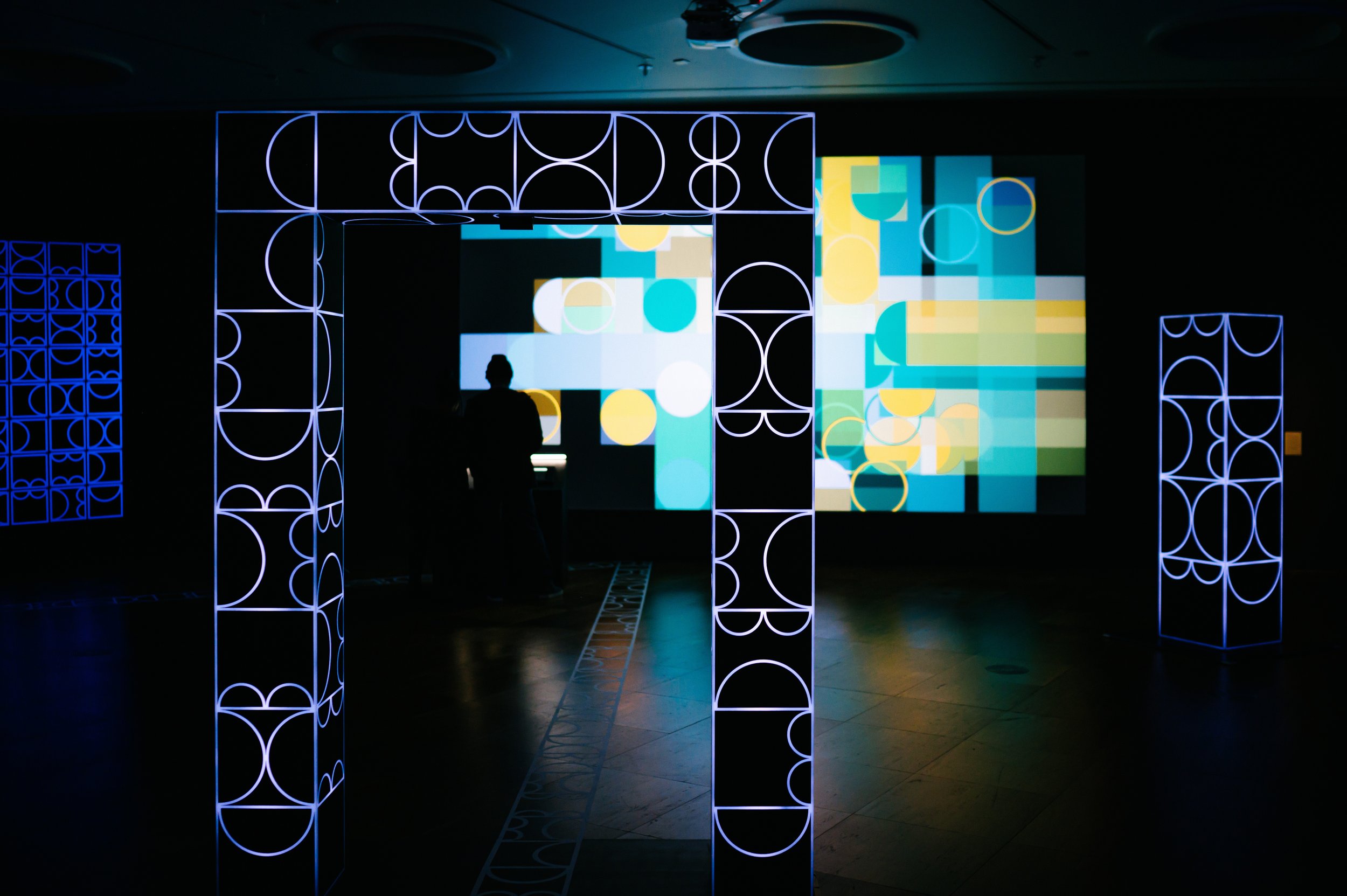















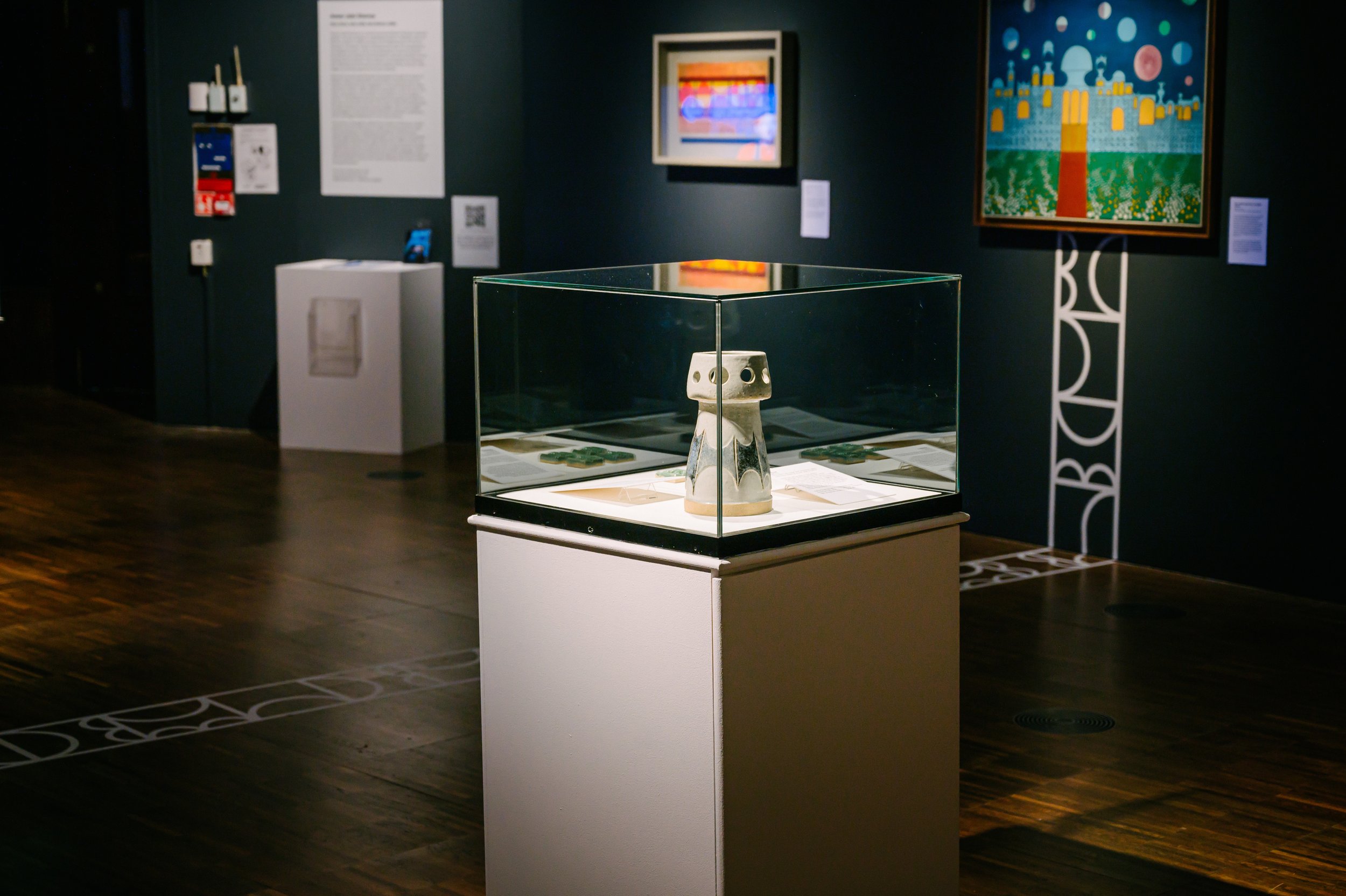
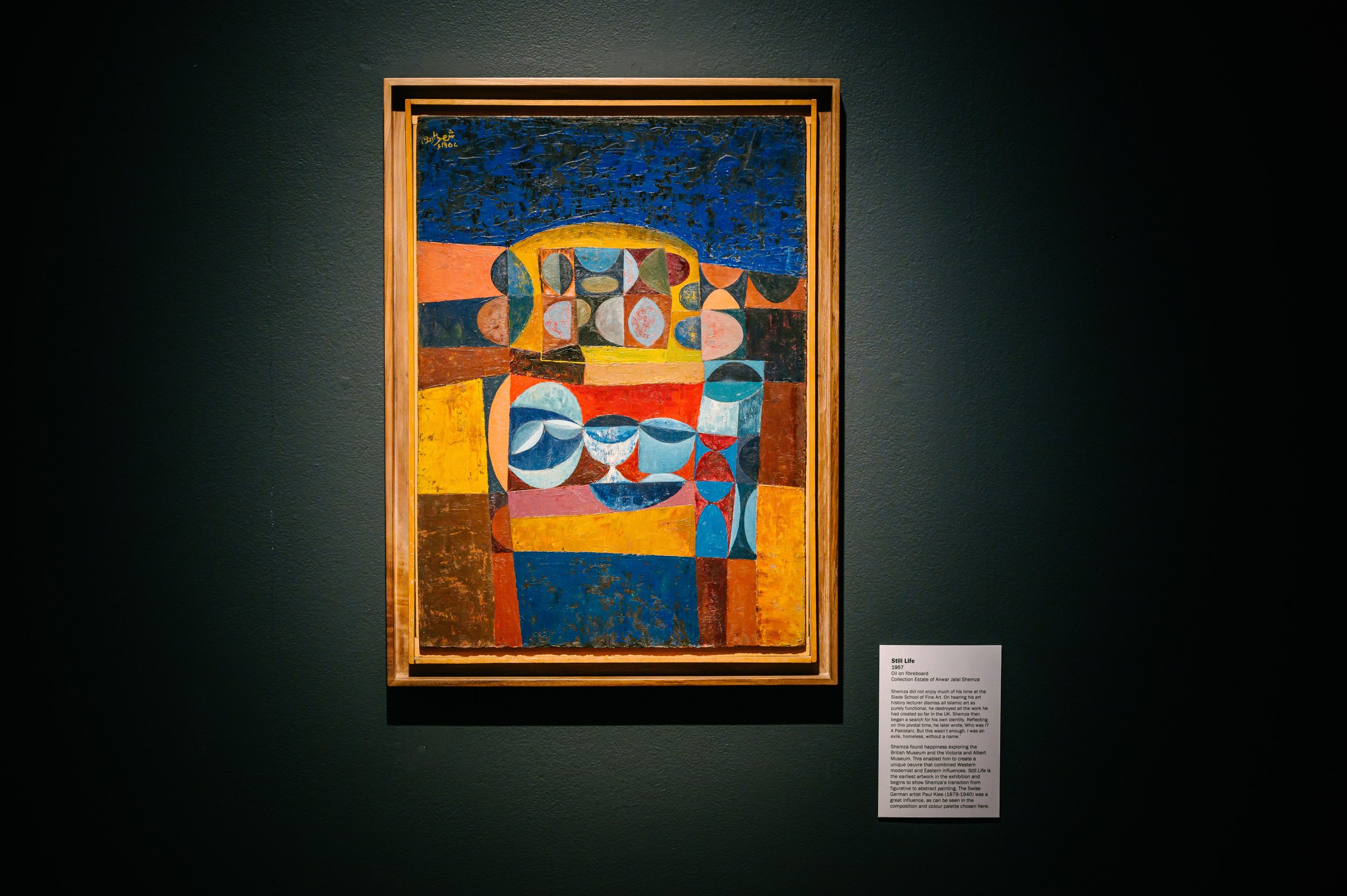

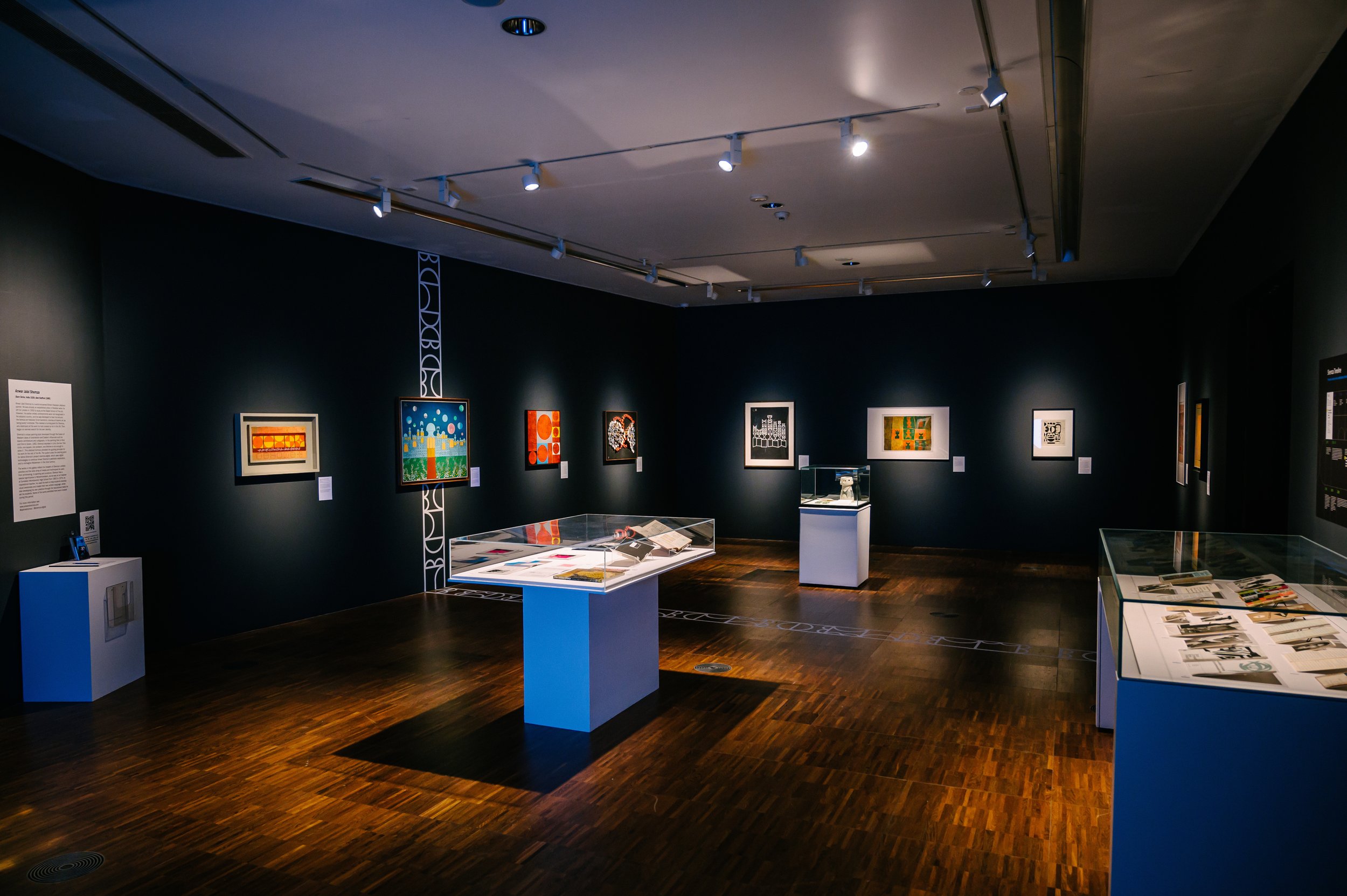




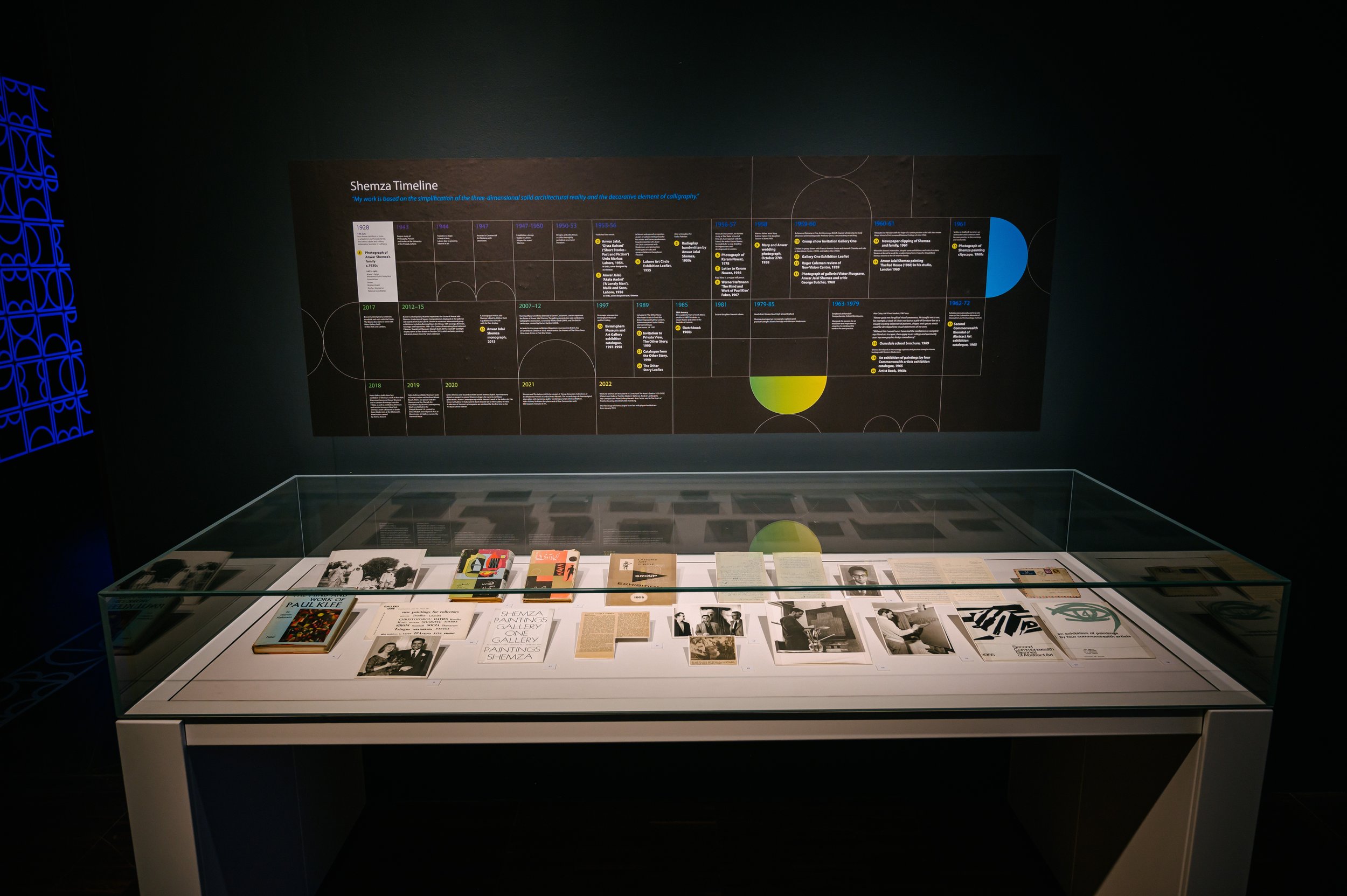








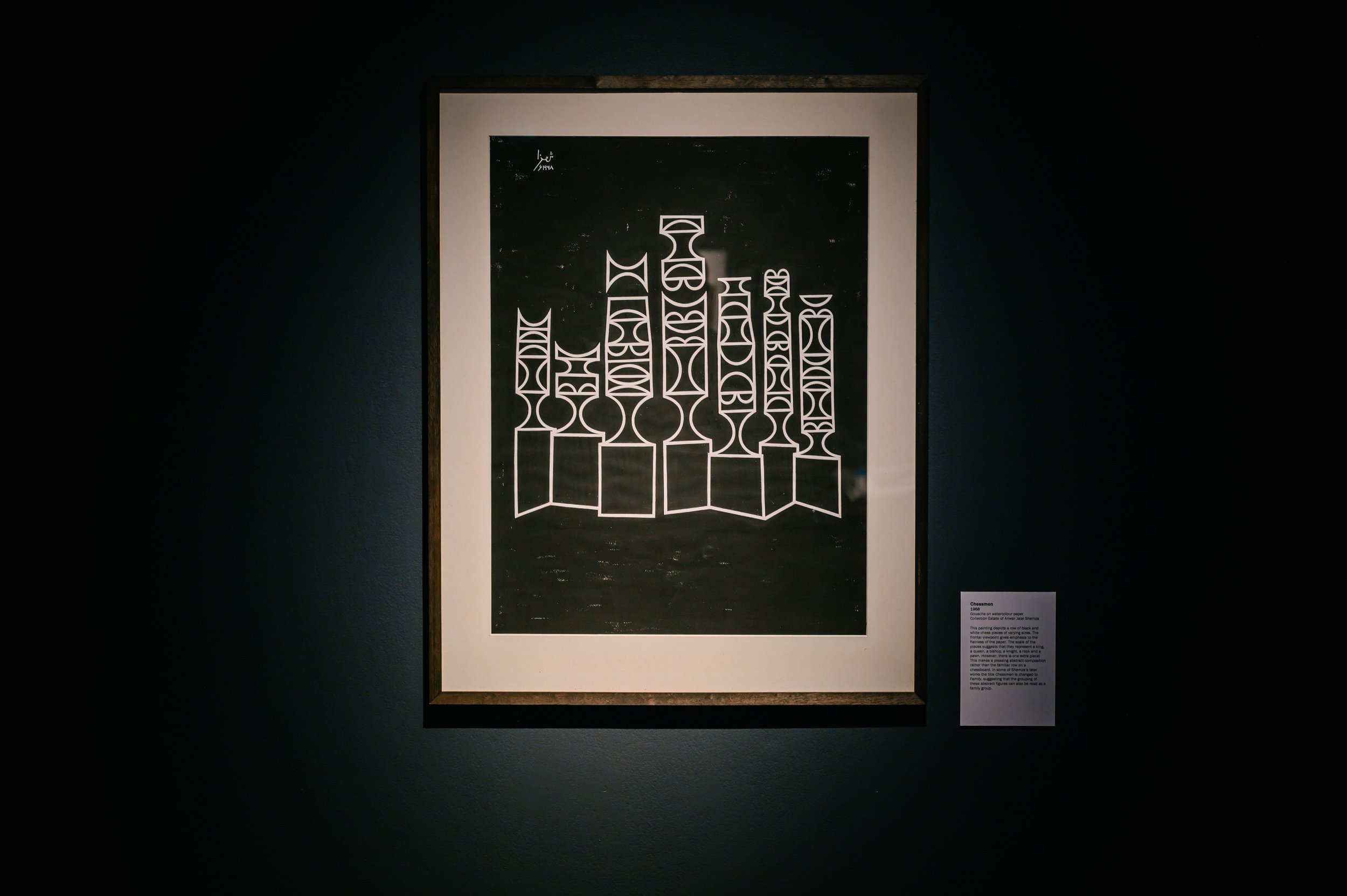










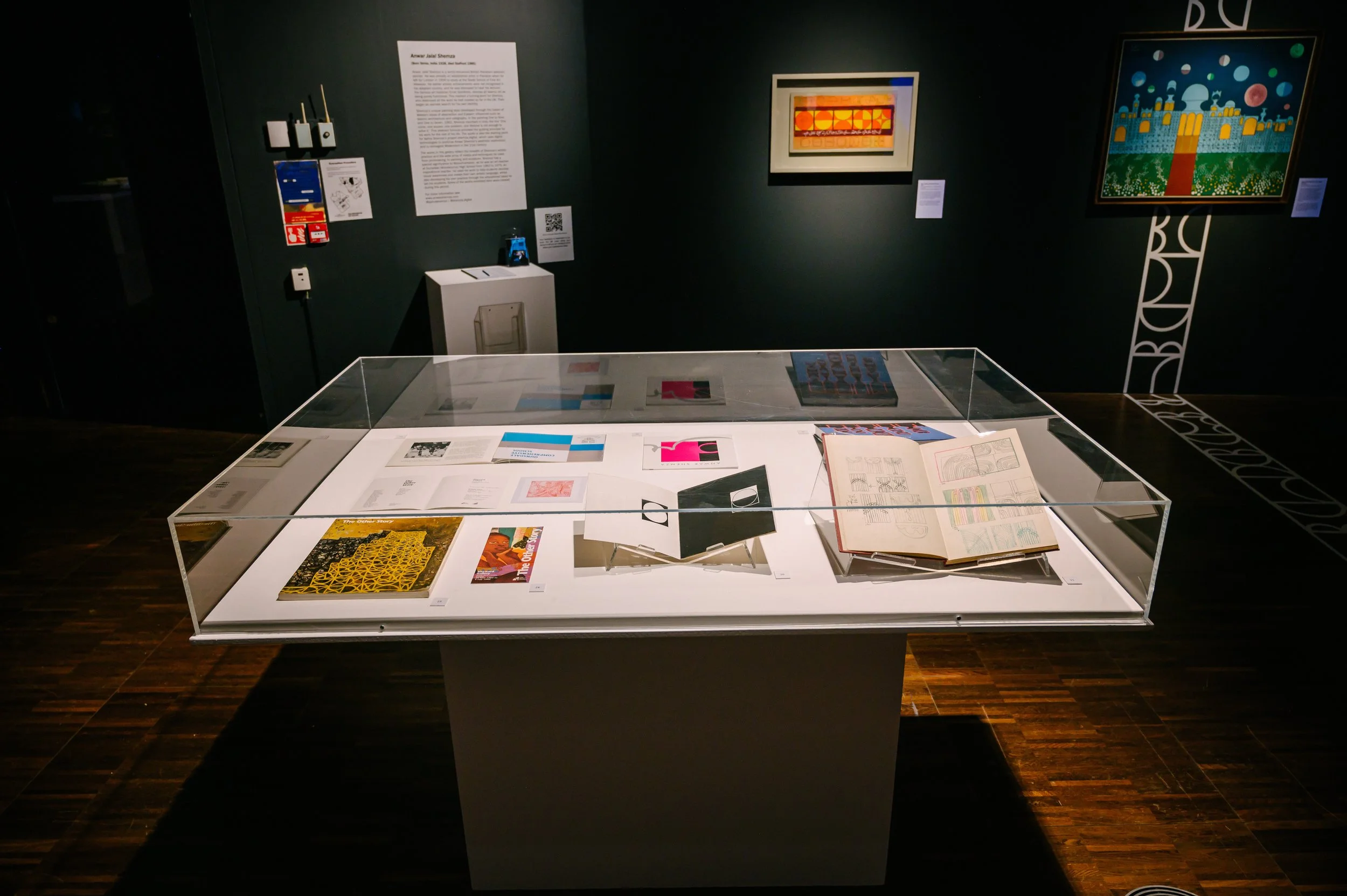

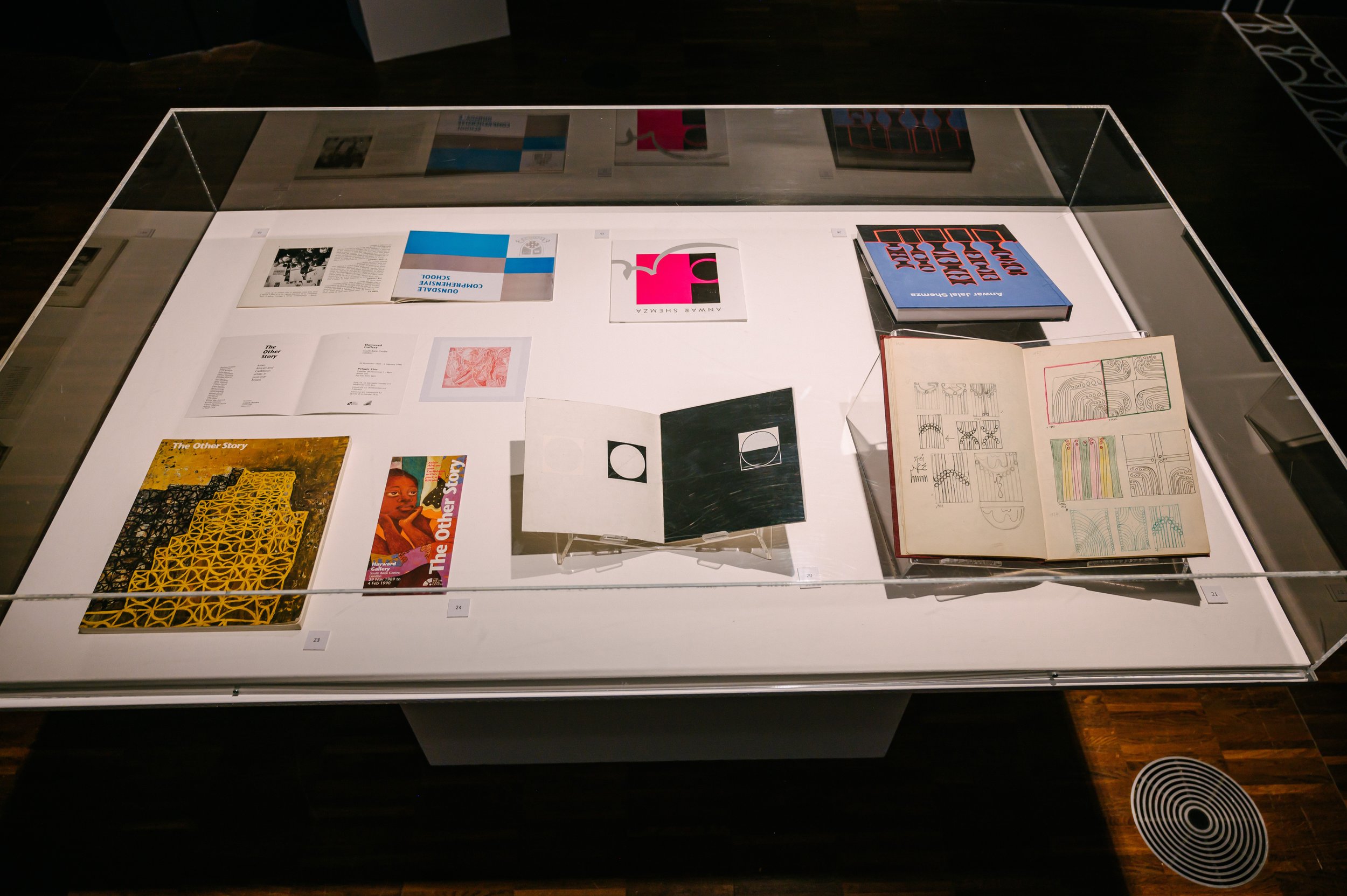

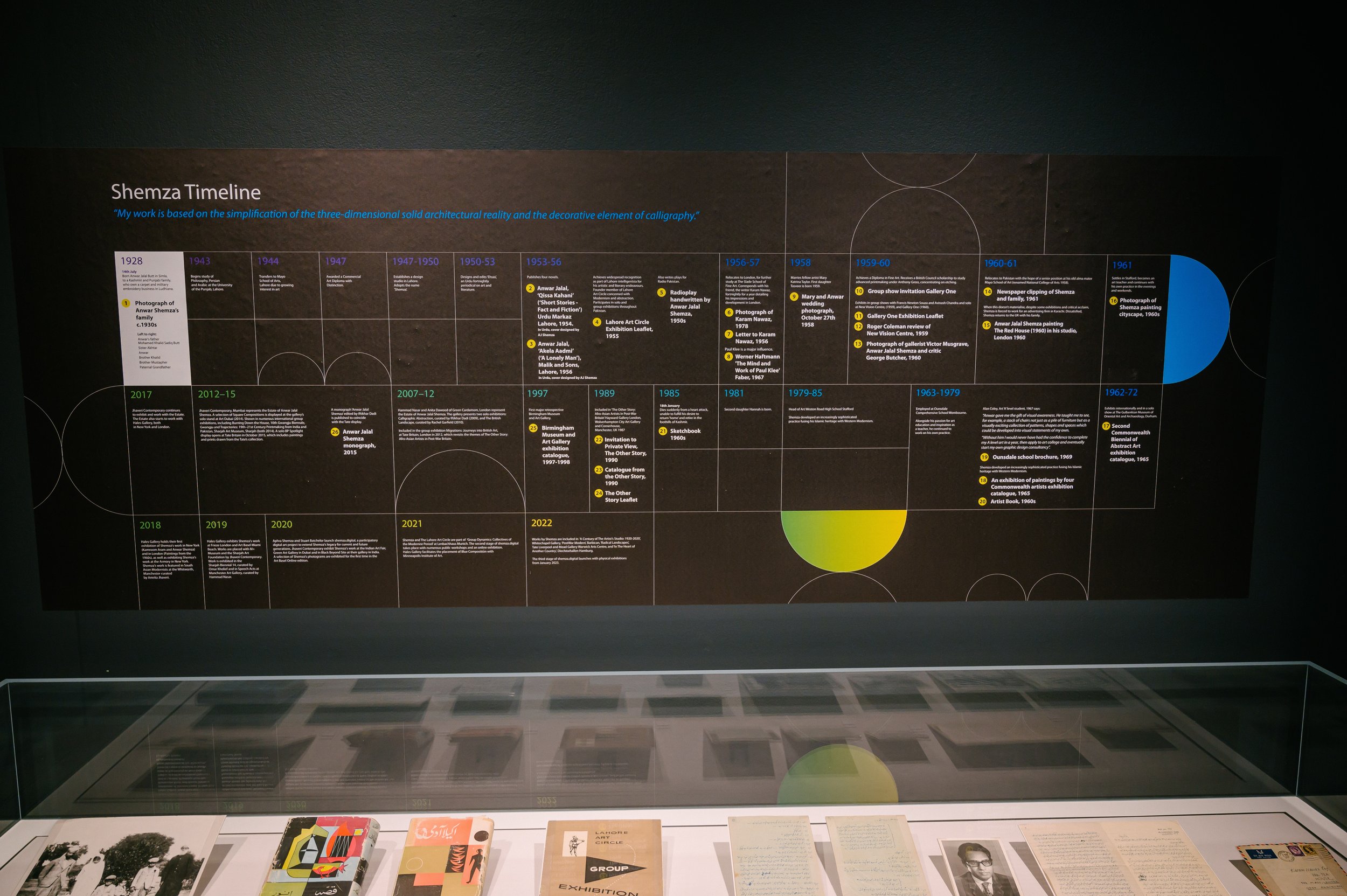
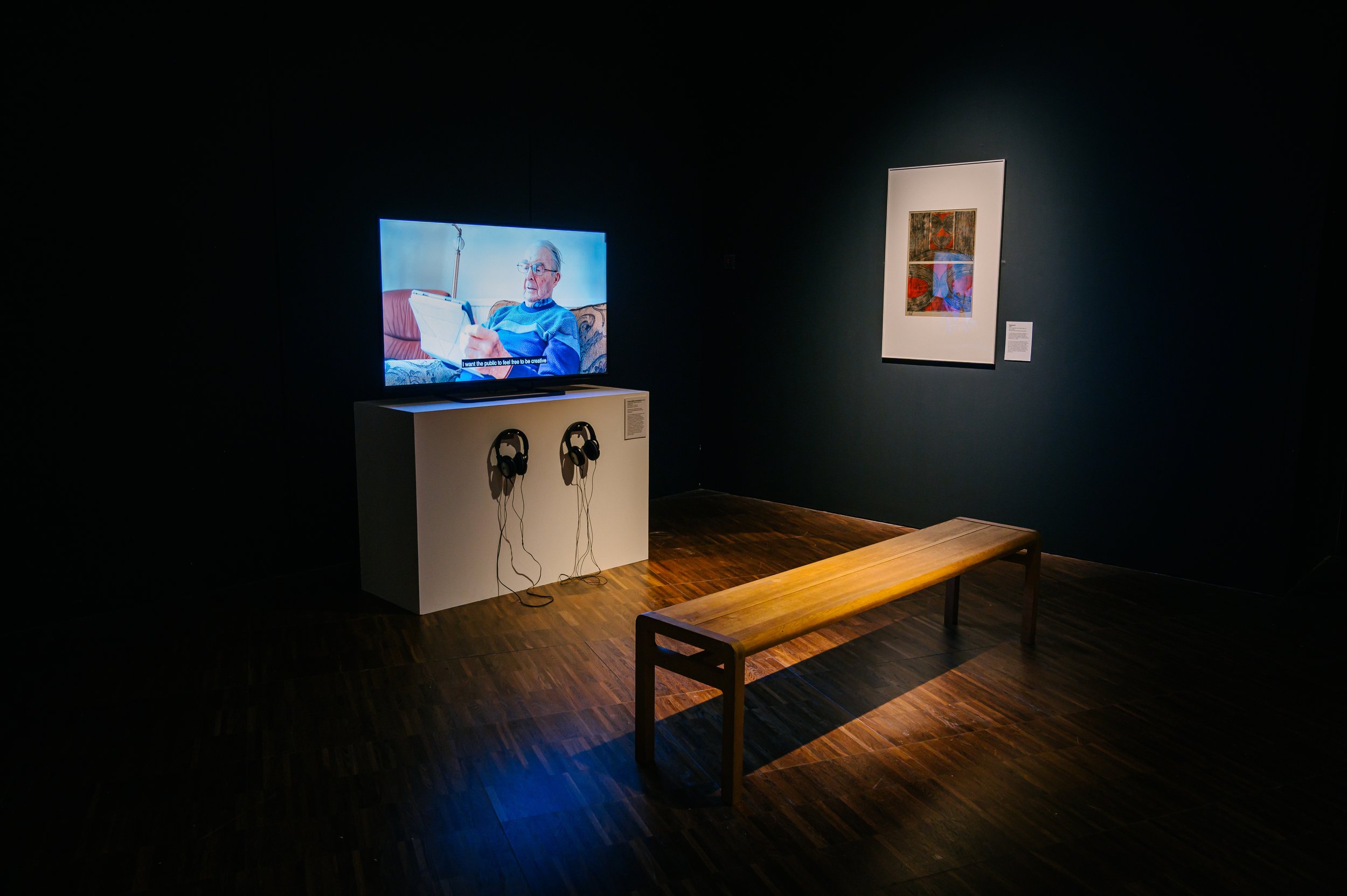













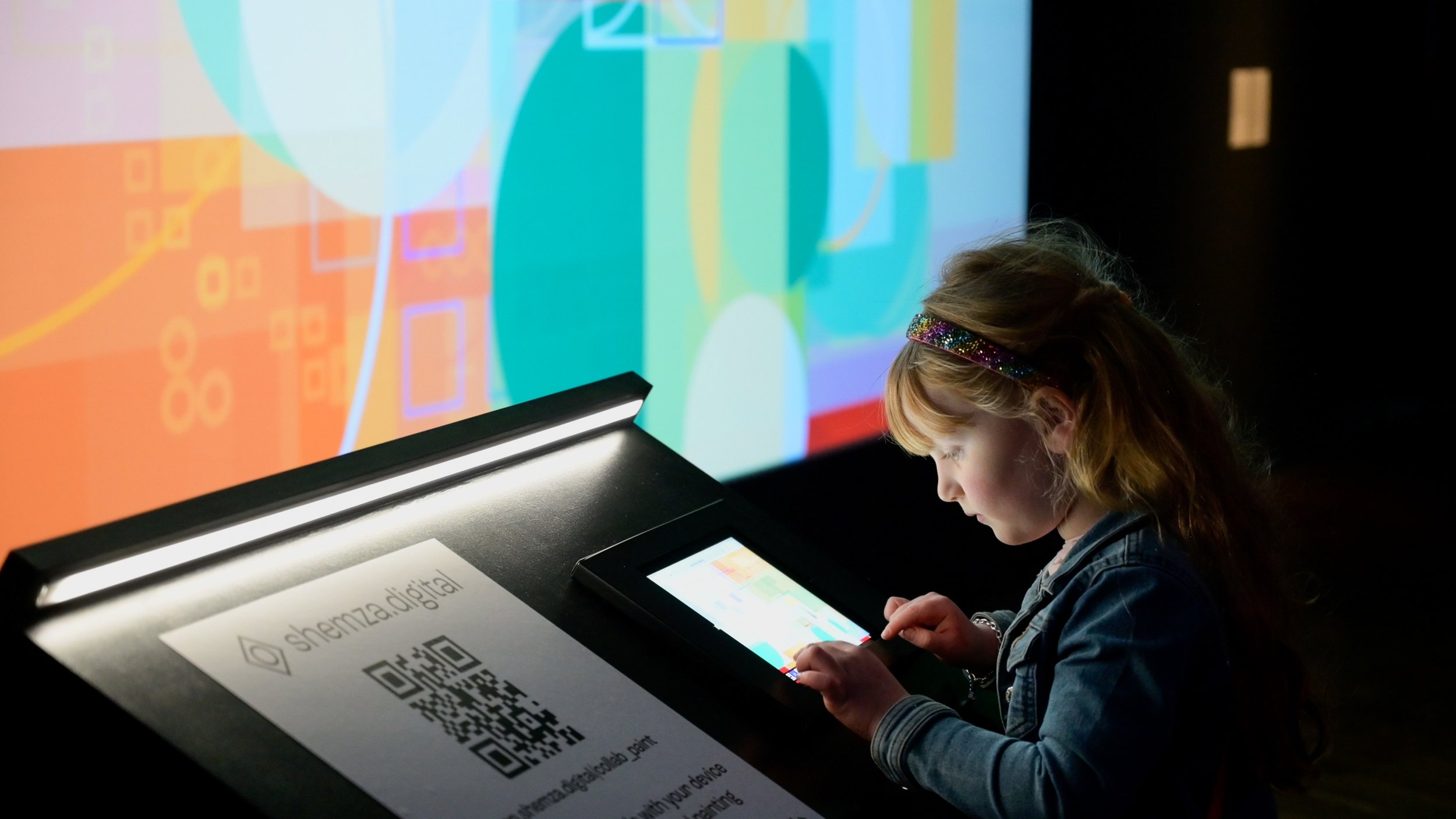








‘One Circle, One Square, One Problem, One lifetime is not enough to solve it.’
Anwar Jalal Shemza, 1962
Shemza Digital: Across Generations is a hybrid exhibition bringing together the abstract art of Anwar Jalal Shemza (1928-1985) and the contemporary digital practice of Aphra Shemza, the artist’s granddaughter.
The British Pakistani painter Anwar Shemza’s visual language combines modernist abstraction with the aesthetics of Islamic architecture and calligraphy. Founded in 2020 by Aphra Shemza in collaboration with the computer artist Stuart Batchelor, the shemza.digital project uses digital media, sculpture and light to create captivating immersive installations inspired by Shemza’s abstract forms.
This first gallery features interactive light-based sculptures that respond to visitors’ movements, and participatory digital projections created by the public. You are invited to create your own digital paintings to add to the ever-evolving archive of work exhibited in the space. A specially commissioned soundscape by NYX and Petit Oiseau accompanies the work. This fuses traditional South Asian instruments with drone and ambient electronic sounds.
The adjoining gallery presents artworks by Anwar Shemza on loan from the artist’s Estate and works from the Wolverhampton collection. An archival display provides historical context in relation to British art history and the impact of migration on contemporary British art today.
The exhibition is also hosted on the Gallery’s website and can be experienced virtually from anywhere in the world.
Find out more at https://www.wolverhamptonart.org.uk/whats-on/shemza/
Artworks
shemza.digital Gallery
Aphra Shemza
shemza.digital acknowledgments, 2022
1080p full HD, 4.55mins Featuring Anwar Jalal Shemza, Aphra Shemza, Stuart Batchelor, NYX, Petit Oiseau and work by members of the public. Photography by Matthew Kaltenborn. Videography Al Jato.
The shemza.digital project was created in 2020 by Aphra Shemza in collaboration with the computer artist Stuart Batchelor and launched at the Art in Flux: Shifting Ground event commissioned by National Gallery X.
Under the direction of Aphra Shemza the project has commissioned NYX & Petit Oiseau to produce a soundscape for this exhibition and she now works with a team of technical specialists to realise her vision for the project including Peter Todd, Jamie Howard and Anna Sycheva.
The project is supported by the Arts Council England.
Private patrons: Taimur Hassan, Hales Gallery, Amrita Jhaveri, ZVM Rangoonwala Foundation and Olivia Aubry.
Public work featured in the film: Aminder Virdee, Ann, Bryn Forbes, Clara, Danielle Jacques, David Wiseman, Deborah Hart, Desire, Ellie, Emma Tod, Floating Concrete, Gah, Jo, Joanne Whitejddojow, John, Julius, Katie, Kom, Lista Pettiboni, Maria Almelia, Milly McHahon, Natasha Trotman, Paprika Pixel, Rana Kadiri, Richard Xavier, Susan, Tiago Carriera, Tina, Zahra and Zoe.
Aphra Shemza, Stuart Batchelor and Peter Todd in collaboration with the public
shemza.digital #8 (archive), 2022
Interactive digital painting application and real time archive animation
The shemza.digital project is based on the work of Aphra Shemza’s grandfather, the well known British/Pakistani painter Anwar Jalal Shemza. In the last 10 years there has been a rethinking of British Art History and migrant artists like Anwar Jalal Shemza are being given the recognition that they deserve. Launched in 2020 in collaboration with the computer artist Stuart Batchelor, shemza.digital uses participatory art as a way to highlight Anwar Shemza’s work to the public and ask them to become actively involved in artmaking by becoming artists themselves.
For shemza.digital #8, Shemza, Batchelor and Todd have created a digital painting application that is accessed via a QR code, where the public is invited to create their own digital paintings and submit them to the ever-growing archive shown in the gallery space.
Aphra Shemza in collaboration with the public
shemza.digital #5, 2022
Programming by Jamie Howard. Interactive light sculpture. Recycled Green Cast acrylic, LED, and bespoke circuit. 2.1 x 1.9 x 1 m
In shemza.digital #5, the viewer is invited to walk through an interactive archway borrowed from Shemza’s City Wall series. Here Aphra Shemza has turned Shemza’s 2D concept which he based on Islamic architecture into something physical again that can be felt and experienced by the viewer. The ultrasonic sensors of shemza.digital #5 measure the visitor’s distance from the work. On approaching the archway, the viewer’s presence makes the lights illuminate, enticing the viewer to walk through the piece. The viewers’ physical interactivity turns them into active, connected participants and this not only further develops the work but creates it - the closer they get, the more they see. Shemza.digital #5 embraces notions of performativity, dialogue and interchange.
The archway motif was designed by students in Aphra Shemza’s Co-creation workshops and the artist has taken this as inspiration to create this piece.
Aphra Shemza in collaboration with the public
shemza.digital #6, 2022
Programming by Jamie Howard. Interactive light sculpture. Recycled Green Cast acrylic, LED, and bespoke circuit. 2.1 x 0.5 x 0.5 m
In shemza.digital #6, the viewer is invited to interact with a column borrowed from Shemza’s City Wall series. Here Aphra Shemza has turned Shemza’s 2D concept which he based on Islamic architecture into something physical again that can be felt and experienced by the viewer. The ultrasonic sensors of shemza.digital #6, measure the visitor’s distance from the work and on approaching the column the viewer’s presence makes the lights illuminate in different colours, enticing the viewer to interact with the piece. The viewers’ physical interactivity turns them into active, connected participants and this not only further develops the work but creates it - the closer they get, the more they see. Shemza.digital #6 embraces notions of performativity, dialogue and interchange.
The column motif was designed by students in Aphra Shemza’s Co-creation workshops and the artist has taken this as inspiration to create this piece.
Aphra Shemza in collaboration with the public
shemza.digital #9, 2022
UV painted board and UV light. 2.5 x 2.5 m
In shemza.digital #9 Aphra Shemza has borrowed the wall and gate motifs from Shemza’s City Walls series, which are based on Islamic architecture. Here she has created a lattice of Shemza’s signature shapes which make reference to the jali screen as seen in Indo-Islamic architecture. The jali screen is a common architectural element that allows privacy and air to circulate inside a building whilst minimising rain and sun. Here the viewer is invited to walk around the piece and imagine the internal and external spaces, the public and private domains.
The screen was inspired by student’s in Aphra Shemza’s Co-creation workshops and the artist has taken this as inspiration to create this piece.
Aphra Shemza, Stuart Batchelor and Peter Todd in collaboration with the public
shemza.digital #4, 2021
Collaborative Painting App
The shemza.digital project is based on the work of Aphra Shemza’s grandfather, the well known British/Pakistani painter Anwar Jalal Shemza. In the last 10 years there has been a rethinking of British Art History and migrant artists like Anwar Jalal Shemza are being given the recognition that they deserve. Launched in 2020 in collaboration with the computer artist Stuart Batchelor, shemza.digital uses participatory art as a way to highlight Anwar Shemza’s work to the public and ask them to become actively involved in artmaking by becoming artists themselves.
For shemza.digital #4 Shemza, Batchelor and Todd have created a collaborative digital painting application which is accessed via a QR code. The public is invited to create a collaborative digital painting with others in the space and vote to finish the painting. Then watch it play back as a real time animation on the screen to their right.
Aphra Shemza, Stuart Batchelor and Peter Todd in collaboration with the public
shemza.digital #7, 2021
Real-time animation of the collaborative painting application
In shemza.digital #7 the finished paintings from the collaborative painting app (shemza.digital #4) are displayed as a real time animation. When not receiving a painting from the artwork, it displays paintings from its archive of finished works creating a dynamic and ever changing digital animation.
NYX & Petit Oiseau
shemza.digital soundscape, 2022
Stereo audio. 15 minutes
The shemza.digital soundscape was commissioned specially for this exhibition and was created by NYX & Petit Oiseau. The work fuses traditional South Asian instruments (Petit Oiseau) with drone & ambient electronic sounds (NYX). The work creates an immersive experience for the viewer as they move around and interact with the shemza.digital exhibition highlighting the coming together of old and new, traditional and digital.
About NYX
NYX is a collaborative drone choir and otherworldly electric chorus, re-embodying live electronics and extended vocal techniques. Using organic and modulated collective voice, they create ecstatic sonic landscapes, punctuated with acoustic glitching, polyphonic overtone and electric textures.
NYX have worked with and been commissioned by Gazelle Twin, Vessel & Rakhi Singh, Holy Other & Pedro Maia, Hatis Noit, Sigur Rós, Laura Misch, LCY, Belinda Zhawi, Do.Om Yoga, Dan Tobin Smith, Nick Cobby, Rosie Hastings & Hannah Quinlan, Iain Forsyth & Jane Pollard, Deeper Into Movies, Arts Council England, PRS Foundation, Southbank Centre, Centre Pompidou, Rewire Festival, Supersonic Festival, London Design Festival, Alighieri (London Fashion Week, QEII Design Award) and many more.
About Petit Oiseau:
Indian Classical player Jatinder Singh Durhailay's graceful mastery of the three hundred year old dilruba breaks new ground in contemporary music with the aid of experimental musician Suren Seneviratne's ambient synthesiser etudes performed with the rare EMU XL-7 workstation. Custom programmed sound-patches dance in curious rhythms alongside Singh's deeply evocative sitar-like wails that hark back to Northern India of many centuries ago.
Anwar Jalal Shemza Gallery
Anwar Jalal Shemza
Still Life, 1957
Oil on fibreboard. 64 x 46.5 cm
Courtesy of the Estate of Anwar Jalal Shemza.
Anwar Jalal Shemza arrived in London from Pakistan in 1956 to study at the Slade School of Fine Art. On arrival in the UK his Pakistani artistic achievements were not recognised and he was dismayed to hear Ernst Gombrich, his art history lecturer, dismiss all Islamic art as being purely functional. That evening Shemza went home and destroyed all the work he had created so far in the UK. He began a search for his own identity. He wrote later “Who was I? A Pakistani. But this wasn’t enough. I was an exile, homeless, without a name.”
Although a regular student at the Slade, Shemza didn’t enjoy much of his time there. He found happiness at the British Museum and the Victoria and Albert. This enabled him to create a unique oeuvre, one that combined Western Modernism with Eastern influences.
‘Still Life’ is the earliest artwork in the exhibition and begins to show Shemza’s transition from figurative to abstract painting. Paul Klee was a great influence as you can see in the composition and colour palette chosen here.
Anwar Jalal Shemza
One to Nine and One to Seven, 1962
Oil on hand-dyed cloth, on mount board on hardboard. 27 x 53 cm
Courtesy of the Estate of Anwar Jalal Shemza.
The quote inscribed in Urdu on this painting translates as ‘One Circle, One Square, One Problem, One lifetime is not enough to solve it’. This abstract formula provided Shemza with the guiding principles which he used in his work for the rest of his life.
In shemza.digital we use this quote as a starting point to continue Anwar Shemza’s aesthetic exploration with the public, reimagining modernism in the 21st Century.
Anwar Jalal Shemza
Fingerprint, 1965
Ink on Japanese handmade paper on mount board.
Courtesy of Wolverhampton Art Gallery.
In 1961 Shemza relocated to Stafford in the West Midlands with his wife Mary Shemza and their daughter Tasveer. He became an art teacher at Ounsdale School, Wombourne in 1963.
This work is part of the Fingerprint series from the early 1960s which was inspired by setting his students tasks to do in class such as drawing their own fingerprints. The Japanese handmade paper was sourced from a specialist supplier in London when the family made the occasional visit to the capital to replenish materials and see exhibitions.
Anwar Jalal Shemza
Square Composition 12, 1963
Oil on hardboard. 61 x 61 cm
Courtesy of the Estate of Anwar Jalal Shemza.
The Square Composition series is a set of 14 paintings which are all created in a square format. In this series you can clearly see how Shemza works to combine different eastern elements with Western Modernism. In Square Composition 3 you see elements from Islamic architecture, in Square Composition 7 you see the Roman alphabet borrowed from the Bauhaus’s topography and in this work, Square Composition 12 there is a return to the simple circle and square. The texture in the painting was created by applying different layers of paint and while wet, walking over scrunched up newspaper on the surface in his flip flops.
In shemza.digital we were inspired by this painting to create the Squircle paint. The paint uses large blocks of colour to create intersecting compositions.
Anwar Jalal Shemza
City at Morning Noon and Night, 1968-69
Oil on canvas.78 x 93 cm
Courtesy of the Estate of Anwar Jalal Shemza.
City at Morning Noon and Night, 1968-69 is from Shemza’s City Wall series. Here you can see the artist drawing on inspiration from Islamic architecture to create a city wall. The artist uses his geometric formula to create walls, archways and minarets. In this painting there is also reference to the waxing and waning of the moon and planets in the sky, which relate us to the movements in the heavens - a common theme in Islamic art.
In shemza.digital we have been inspired by the woven motifs in this painting to create our Weave paint. We have also borrowed the formation of an archway from this piece which you will see exhibited physically in the space in shemza.digital #5 our interactive light sculpture.
Anwar Jalal Shemza
Untitled, 1966
Wood on Chipboard and matt emulsion paint. 61.5 x 76 x 11 cm
Courtesy of the Estate of Anwar Jalal Shemza.
In 1961 Shemza relocated to Stafford in the West Midlands with his wife Mary Shemza and their daughter Tasveer and became an art teacher at Ounsdale School, Wombourne. Whilst teaching he noticed there had been some tables and chairs thrown into a skip outside the school and decided to reuse the wooden materials to create a series of wood reliefs. In Untitled, 1966 Shemza cuts different sized cylinders from these items and attaches them to the backboard to create a topographical composition.
In shemza.digital’s Mosaic paint we borrow this element to create a string of circles or squares that flow across the page when clicked and dragged.
Anwar Jalal Shemza
Chessmen, 1968
Gouache on watercolour paper. 72 x 56 cm
Courtesy of the Estate of Anwar Jalal Shemza.
The painting ‘Chessmen’ 1968 depicts a row of black and white chess pieces of varying sizes. The frontal view emphasises the flatness and two-dimensional quality of the paper. The sizing of the pieces could correspond to a King, a Queen, a Bishop, a Knight, a Rook and a Pawn. However, there is one extra piece which makes a pleasing abstract composition rather than the familiar row on a chessboard. In some of Shemza’s later works the name ‘Chessmen’ is swapped for ‘Family’ as the grouping of these abstract figures also illustrates a family grouping.
Anwar Jalal Shemza
Chessmen II, 1963
Ink on Japanese handmade paper on mount board.
Courtesy of Wolverhampton Art Gallery.
‘Chessmen II’ is very different from the other one in this exhibition. Here the pieces are depicted within their individual squares on the chessboard. The coloured inks indicate opposing pieces, all outlined in black. The background is composed of Japanese handmade paper, which lends a much more textural quality suggesting the appearance of textiles or carpet.
Anwar Jalal Shemza
The Gate, 1959
Etching
Courtesy of Wolverhampton Art Gallery.
After completing his Diploma at the Slade School of Fine Art in 1959 Shemza received a British Council scholarship to study an advanced course in printmaking. This concentrated on etching and was led by Anthony Gross. Shemza produced many fine etchings during this period. In ‘The Gate’ one can see the characteristic shapes joined by other rounded forms.
Aphra Shemza has complimented this etching with her hanging work lit by UV light, shemza.digital #9. A contemporary take on a jali screen, the work echoes the motifs in this work.
Anwar Jalal Shemza
The Letter, 1968
Etching
Courtesy of Wolverhampton Art Gallery.
The Letter (or Love letter) series was explored most fully by Shemza during the 1960’s. Taking inspiration from his visits to the British Museum and the illuminated manuscripts he found there, Shemza created his own ‘page of text’. On the canvas the geometric passages vary in modulation and frequency. Three highlighted ‘illustrations’ revisit a Western manuscript design. In the borders there are a further four, one of which shows the waning of the moon as it is a common theme in Islamic art.
In shemza.digital we have been inspired by the woven motifs in this etching to create our Weave paint.
Anwar Jalal Shemza
Magic Carpet, 1961
Oil on hand dyed cloth on hardboard. 56 x 46 cm
Courtesy of the Estate of Anwar Jalal Shemza.
The oil paints shimmering in this ‘Magic Carpet’ give a mystical quality to the work. It echoes a prayer rug which is enhanced by the hand-dyed cloth with an unfinished edge, used as a background .
Shemza uses the Modernist construct of making the shapes smaller, in order to provide an abstract perspective, towards the top of the composition.
‘Magic Carpets’ were a theme throughout Shemza’s practice, explored in all the media he utilised from the 1950’s until his death in 1985.
In shemza.digital we have been inspired by the woven motifs in this etching to create our Weave paint.
Anwar Jalal Shemza
Untitled, 1960-1970
Stoneware with oxide and stoneware glaze. 26.5 x 14 x 14 cm
Courtesy of the Estate of Anwar Jalal Shemza.
Whilst teaching at Ounsdale school Shemza also had access to the pottery department, which allowed him to make a number of ceramic pieces. In this stoneware vase you can see the familiar shapes forming a wall and the circles above looking like moons in the sky. The piece is also part of the ‘Chessmen’ series, where you can see the figures morph out of the canvas and into three dimensional form.
Aphra Shemza takes inspiration from Shemza’s 3D work to create her interactive light sculpture, shemza.digital #6.
Anwar Jalal Shemza
Untitled, 1960-1970
Stoneware 5 x 5 cm (each). Pressed tiles from plaster original, group of 4
Courtesy of the Estate of Anwar Jalal Shemza.
These tiles have a Celadon glaze, which was developed by the Chinese in the 2nd millennium BC. ‘Greenware’ was much prized by the Imperial Court of the Shang dynasty onwards until it was replaced by the painted blue and white ware of the 13th century. The term however, has a purely European origin and may have originated from Saladin the Ayyubid Sultan who in 1171 sent forty pieces to Nur ad-Din Zengi the Sultan of Syria.
In Islam the colour green is associated with paradise (as mentioned in the Quran). The gemstone turquoise was often used for holy inscriptions and therefore this choice of glaze is of vital importance to Shemza.
Acknowledgements:
Anwar Jalal Shemza, artist (1928-1985)
Aphra Shemza, artist, curator and Manager of the Estate of Anwar Jalal Shemza
With special thanks to the Estate of Anwar Jalal Shemza and Tasveer Shemza
shemza.digital team:
Stuart Batchelor, artist and co-founder of the project with Aphra Shemza in 2020
NYX, musician, commissioned soundscape
Petit Oiseau, musician, commissioned soundscape
Peter Todd, artist / programmer, digital works #4, #7 & #8 and virtual exhibition programming
Anna Schycheva, 3D designer, virtual sculptures #5 & #6 and 3D design of the virtual exhibition
Jamie Howard, programmer, interactive light sculptures #5 & #6
Private patrons:
Taimur Hassan
Hales Gallery
Amrita Jhaveri
ZVM Rangoonwala Foundation
Olivia Aubry
Ishrat Kanga
Supported by the Arts Council England
Find out more at https://www.wolverhamptonart.org.uk/whats-on/shemza/




